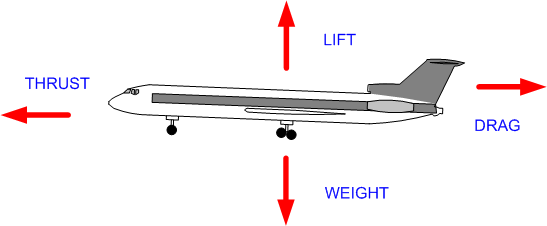How exactly do airplanes fly? You’d be surprised at how many people don’t know the answer to that question. The truth of the matter is that air travel has had a profound effect on our society over the last few decades, and has influenced the development of our civilization in ways that are sometimes difficult to comprehend, or even imagine. Every day, thousands upon thousands of people embark on long distance flights, while many more utilize aircraft for shorter journeys, or simply for pleasure. It is astounding, then, that so few of us question just how an airplane works. At first glance it seems like magic, and perhaps that should bother us, but the principles involved are so basic, so foolproof, that in practice we rarely find ourselves worrying about the actual mechanics of flight.
There are four principle forces that act upon an aircraft: lift, gravity, thrust, and drag. These forces tend to work in counterpart; for example, thrust is the opposite force of drag, while lift is the opposite force of gravity. Lift and thrust can be described as positive forces, driving the aircraft up and forward, although these actual directions can change with the design, purpose, and usage of the aircraft. Meanwhile, drag and gravity are considered negative forces, pulling the aircraft down and back. Similar to the two positive forces, the actual direction of these 'negative' force vectors could very well change based on whatever particular situation may arise during the process of flight.

In most cases, lift is provided by the wings, while thrust is provided by a jet engine and/or prop. Drag is a natural force occurring due to wind and air resistance on the wing, while gravity is a naturally occurring force that is common everywhere on our planet (e.g., things fall down).
Although these principles seem simple at first glance, do we really understand how they work? We do have a pretty good working knowledge of gravity, and it’s rather apparent how engines propel an aircraft through the air. But to examine and fully understand the principles of lift and drag, we must take a closer look at an airplane wing, and the airfoil design in general.
At first glance, airplane wings appear to be fairly straightforward, but once again first appearances can be deceiving. In truth, airplane wings are specifically designed and engineered to cause a difference in the air pressure above and below the wing. The principle that is utilized in this situation is otherwise known as Bernoulli’s Principle, and can be summed up as thus:
The faster that a fluid moves (our fluid in this case being air), the less pressure it generates. Airplane wings are designed so that air travels faster over the top of the wing than the bottom of the wing, creating more pressure on the bottom than on the top. This difference in pressure creates a partial vacuum over the top of the wing, causing the wing to be lifted into the low pressure area located directly above it. There’s even a nice fancy picture there for you too look at in order to better grasp the process involved.
The faster that a fluid moves (our fluid in this case being air), the less pressure it generates. Airplane wings are designed so that air travels faster over the top of the wing than the bottom of the wing, creating more pressure on the bottom than on the top. This difference in pressure creates a partial vacuum over the top of the wing, causing the wing to be lifted into the low pressure area located directly above it. There’s even a nice fancy picture there for you too look at in order to better grasp the process involved.
 Drag is the other principle that we may not completely understand. Believe it or not, everything has a certain mass, even the air around us. When an aircraft is propelled forward, air is forced out and around the nose of the aircraft, creating friction. It is this friction that we call drag, and it works in the opposite direction of the aircraft’s motion.
Drag is the other principle that we may not completely understand. Believe it or not, everything has a certain mass, even the air around us. When an aircraft is propelled forward, air is forced out and around the nose of the aircraft, creating friction. It is this friction that we call drag, and it works in the opposite direction of the aircraft’s motion. That’s it. Mostly. Four fundamental process, four basic forces, and although the principles involved are far more complicated than I make them out to be, the basic elements of flight really are that simple.

No comments:
Post a Comment